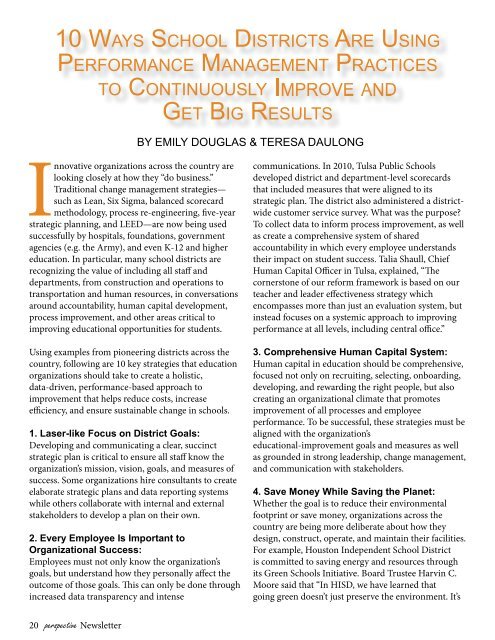Perspective (August-October 2013) - aaspa
Perspective (August-October 2013) - aaspa
Perspective (August-October 2013) - aaspa
Create successful ePaper yourself
Turn your PDF publications into a flip-book with our unique Google optimized e-Paper software.
Innovative organizations across the country arelooking closely at how they “do business.”Traditional change management strategies—such as Lean, Six Sigma, balanced scorecardmethodology, process re-engineering, five-yearstrategic planning, and LEED—are now being usedsuccessfully by hospitals, foundations, governmentagencies (e.g. the Army), and even K-12 and highereducation. In particular, many school districts arerecognizing the value of including all staff anddepartments, from construction and operations totransportation and human resources, in conversationsaround accountability, human capital development,process improvement, and other areas critical toimproving educational opportunities for students.Using examples from pioneering districts across thecountry, following are 10 key strategies that educationorganizations should take to create a holistic,data-driven, performance-based approach toimprovement that helps reduce costs, increaseefficiency, and ensure sustainable change in schools.Developing and communicating a clear, succinctstrategic plan is critical to ensure all staff know theorganization’s mission, vision, goals, and measures ofsuccess. Some organizations hire consultants to createelaborate strategic plans and data reporting systemswhile others collaborate with internal and externalstakeholders to develop a plan on their own.Employees must not only know the organization’sgoals, but understand how they personally affect theoutcome of those goals. This can only be done throughincreased data transparency and intensecommunications. In 2010, Tulsa Public Schoolsdeveloped district and department-level scorecardsthat included measures that were aligned to itsstrategic plan. The district also administered a districtwidecustomer service survey. What was the purpose?To collect data to inform process improvement, as wellas create a comprehensive system of sharedaccountability in which every employee understandstheir impact on student success. Talia Shaull, ChiefHuman Capital Officer in Tulsa, explained, “Thecornerstone of our reform framework is based on ourteacher and leader effectiveness strategy whichencompasses more than just an evaluation system, butinstead focuses on a systemic approach to improvingperformance at all levels, including central office.”Human capital in education should be comprehensive,focused not only on recruiting, selecting, onboarding,developing, and rewarding the right people, but alsocreating an organizational climate that promotesimprovement of all processes and employeeperformance. To be successful, these strategies must bealigned with the organization’seducational-improvement goals and measures as wellas grounded in strong leadership, change management,and communication with stakeholders.Whether the goal is to reduce their environmentalfootprint or save money, organizations across thecountry are being more deliberate about how theydesign, construct, operate, and maintain their facilities.For example, Houston Independent School Districtis committed to saving energy and resources throughits Green Schools Initiative. Board Trustee Harvin C.Moore said that “In HISD, we have learned thatgoing green doesn’t just preserve the environment. It’s20 perspective Newsletter


